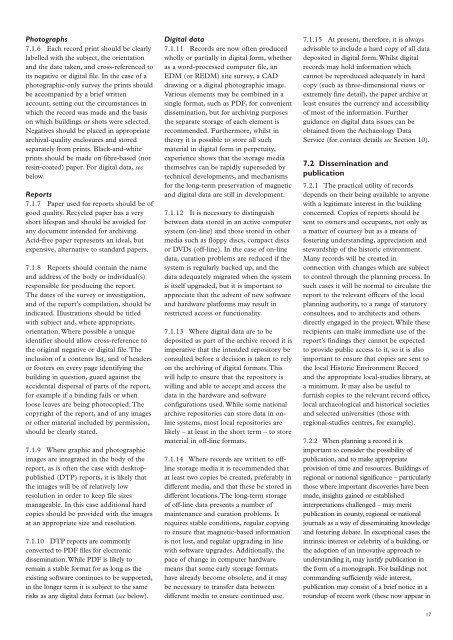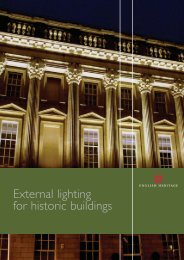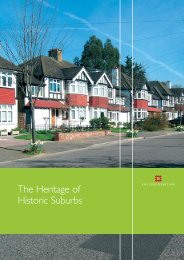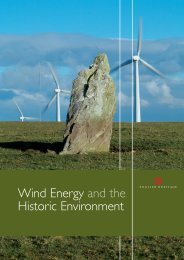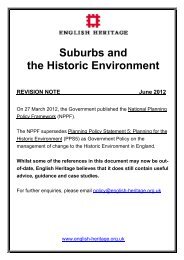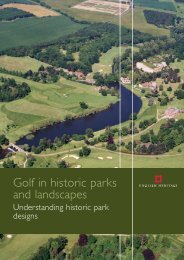Understanding Historic Buildings - HELM
Understanding Historic Buildings - HELM
Understanding Historic Buildings - HELM
Create successful ePaper yourself
Turn your PDF publications into a flip-book with our unique Google optimized e-Paper software.
Photographs<br />
7.1.6 Each record print should be clearly<br />
labelled with the subject, the orientation<br />
and the date taken, and cross-referenced to<br />
its negative or digital file. In the case of a<br />
photographic-only survey the prints should<br />
be accompanied by a brief written<br />
account, setting out the circumstances in<br />
which the record was made and the basis<br />
on which buildings or shots were selected.<br />
Negatives should be placed in appropriate<br />
archival-quality enclosures and stored<br />
separately from prints. Black-and-white<br />
prints should be made on fibre-based (not<br />
resin-coated) paper. For digital data, see<br />
below.<br />
Reports<br />
7.1.7 Paper used for reports should be of<br />
good quality. Recycled paper has a very<br />
short lifespan and should be avoided for<br />
any document intended for archiving.<br />
Acid-free paper represents an ideal, but<br />
expensive, alternative to standard papers.<br />
7.1.8 Reports should contain the name<br />
and address of the body or individual(s)<br />
responsible for producing the report.<br />
The dates of the survey or investigation,<br />
and of the report’s compilation, should be<br />
indicated. Illustrations should be titled<br />
with subject and, where appropriate,<br />
orientation. Where possible a unique<br />
identifier should allow cross-reference to<br />
the original negative or digital file. The<br />
inclusion of a contents list, and of headers<br />
or footers on every page identifying the<br />
building in question, guard against the<br />
accidental dispersal of parts of the report,<br />
for example if a binding fails or when<br />
loose leaves are being photocopied. The<br />
copyright of the report, and of any images<br />
or other material included by permission,<br />
should be clearly stated.<br />
7.1.9 Where graphic and photographic<br />
images are integrated in the body of the<br />
report, as is often the case with desktoppublished<br />
(DTP) reports, it is likely that<br />
the images will be of relatively low<br />
resolution in order to keep file sizes<br />
manageable. In this case additional hard<br />
copies should be provided with the images<br />
at an appropriate size and resolution.<br />
7.1.10 DTP reports are commonly<br />
converted to PDF files for electronic<br />
dissemination. While PDF is likely to<br />
remain a stable format for as long as the<br />
existing software continues to be supported,<br />
in the longer term it is subject to the same<br />
risks as any digital data format (see below).<br />
Digital data<br />
7.1.11 Records are now often produced<br />
wholly or partially in digital form, whether<br />
as a word-processed computer file, an<br />
EDM (or REDM) site survey, a CAD<br />
drawing or a digital photographic image.<br />
Various elements may be combined in a<br />
single format, such as PDF, for convenient<br />
dissemination, but for archiving purposes<br />
the separate storage of each element is<br />
recommended. Furthermore, whilst in<br />
theory it is possible to store all such<br />
material in digital form in perpetuity,<br />
experience shows that the storage media<br />
themselves can be rapidly superseded by<br />
technical developments, and mechanisms<br />
for the long-term preservation of magnetic<br />
and digital data are still in development.<br />
7.1.12 It is necessary to distinguish<br />
between data stored in an active computer<br />
system (on-line) and those stored in other<br />
media such as floppy discs, compact discs<br />
or DVDs (off-line). In the case of on-line<br />
data, curation problems are reduced if the<br />
system is regularly backed up, and the<br />
data adequately migrated when the system<br />
is itself upgraded, but it is important to<br />
appreciate that the advent of new software<br />
and hardware platforms may result in<br />
restricted access or functionality.<br />
7.1.13 Where digital data are to be<br />
deposited as part of the archive record it is<br />
imperative that the intended repository be<br />
consulted before a decision is taken to rely<br />
on the archiving of digital formats. This<br />
will help to ensure that the repository is<br />
willing and able to accept and access the<br />
data in the hardware and software<br />
configurations used. While some national<br />
archive repositories can store data in online<br />
systems, most local repositories are<br />
likely – at least in the short term – to store<br />
material in off-line formats.<br />
7.1.14 Where records are written to offline<br />
storage media it is recommended that<br />
at least two copies be created, preferably in<br />
different media, and that these be stored in<br />
different locations. The long-term storage<br />
of off-line data presents a number of<br />
maintenance and curation problems. It<br />
requires stable conditions, regular copying<br />
to ensure that magnetic-based information<br />
is not lost, and regular upgrading in line<br />
with software upgrades. Additionally, the<br />
pace of change in computer hardware<br />
means that some early storage formats<br />
have already become obsolete, and it may<br />
be necessary to transfer data between<br />
different media to ensure continued use.<br />
7.1.15 At present, therefore, it is always<br />
advisable to include a hard copy of all data<br />
deposited in digital form. Whilst digital<br />
records may hold information which<br />
cannot be reproduced adequately in hard<br />
copy (such as three-dimensional views or<br />
extremely fine detail), the paper archive at<br />
least ensures the currency and accessibility<br />
of most of the information. Further<br />
guidance on digital data issues can be<br />
obtained from the Archaeology Data<br />
Service (for contact details see Section 10).<br />
7.2 Dissemination and<br />
publication<br />
7.2.1 The practical utility of records<br />
depends on their being available to anyone<br />
with a legitimate interest in the building<br />
concerned. Copies of reports should be<br />
sent to owners and occupants, not only as<br />
a matter of courtesy but as a means of<br />
fostering understanding, appreciation and<br />
stewardship of the historic environment.<br />
Many records will be created in<br />
connection with changes which are subject<br />
to control through the planning process. In<br />
such cases it will be normal to circulate the<br />
report to the relevant officers of the local<br />
planning authority, to a range of statutory<br />
consultees, and to architects and others<br />
directly engaged in the project. While these<br />
recipients can make immediate use of the<br />
report’s findings they cannot be expected<br />
to provide public access to it, so it is also<br />
important to ensure that copies are sent to<br />
the local <strong>Historic</strong> Environment Record<br />
and the appropriate local-studies library, at<br />
a minimum. It may also be useful to<br />
furnish copies to the relevant record office,<br />
local archaeological and historical societies<br />
and selected universities (those with<br />
regional-studies centres, for example).<br />
7.2.2 When planning a record it is<br />
important to consider the possibility of<br />
publication, and to make appropriate<br />
provision of time and resources. <strong>Buildings</strong> of<br />
regional or national significance – particularly<br />
those where important discoveries have been<br />
made, insights gained or established<br />
interpretations challenged – may merit<br />
publication in county, regional or national<br />
journals as a way of disseminating knowledge<br />
and fostering debate. In exceptional cases the<br />
intrinsic interest or celebrity of a building, or<br />
the adoption of an innovative approach to<br />
understanding it, may justify publication in<br />
the form of a monograph. For buildings not<br />
commanding sufficiently wide interest,<br />
publication may consist of a brief notice in a<br />
roundup of recent work (these now appear in<br />
17


